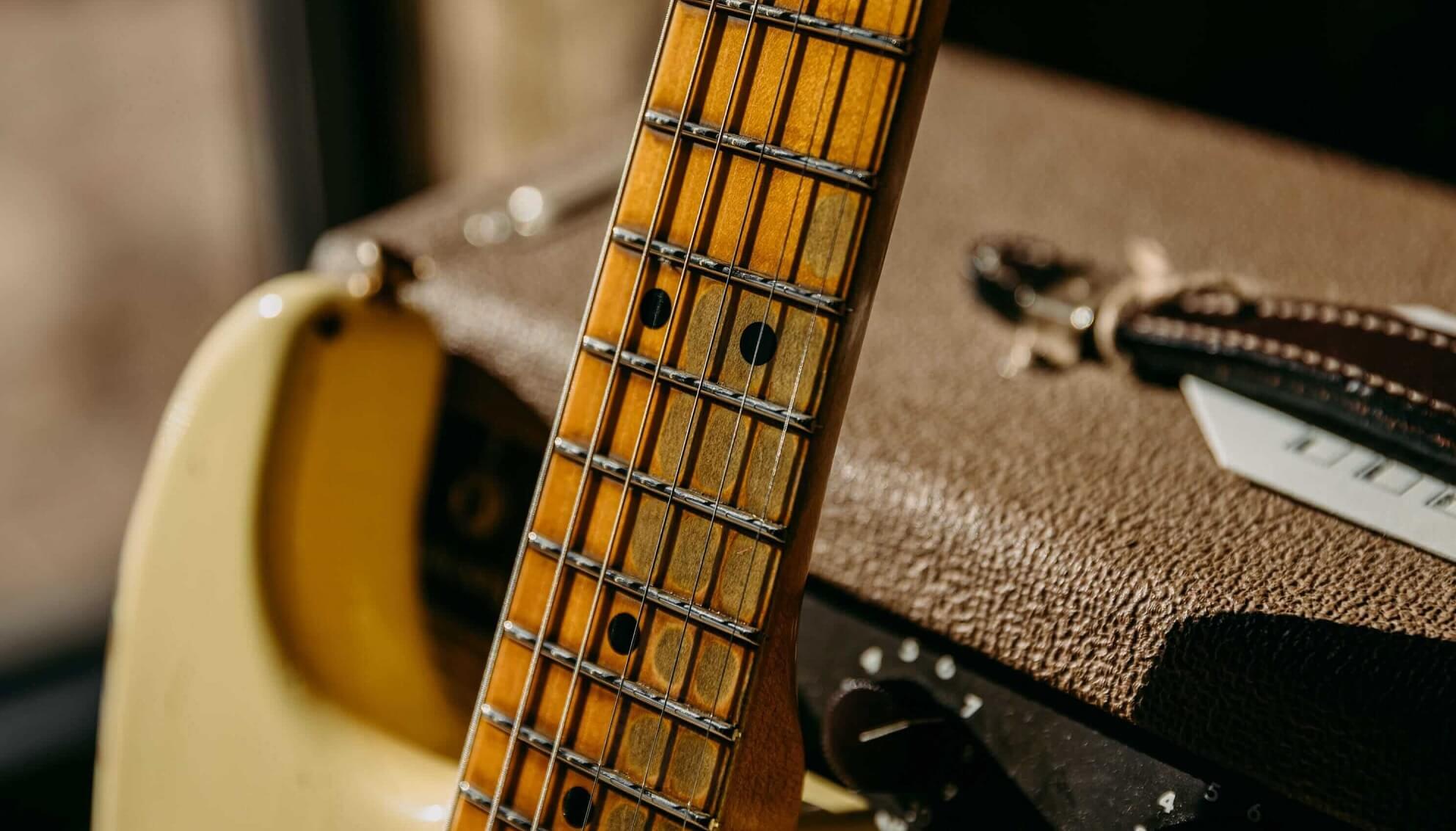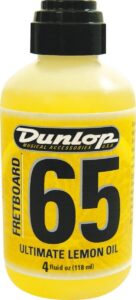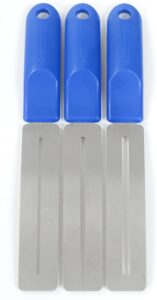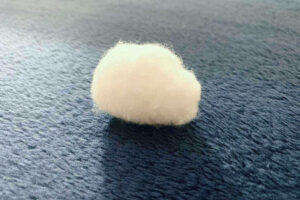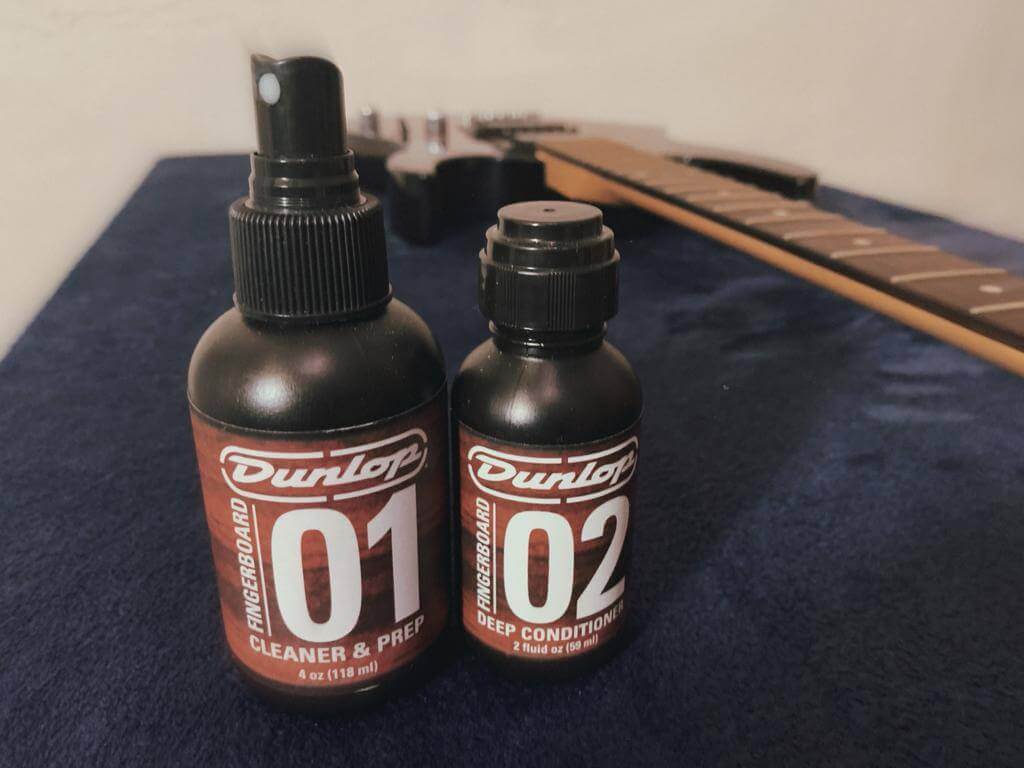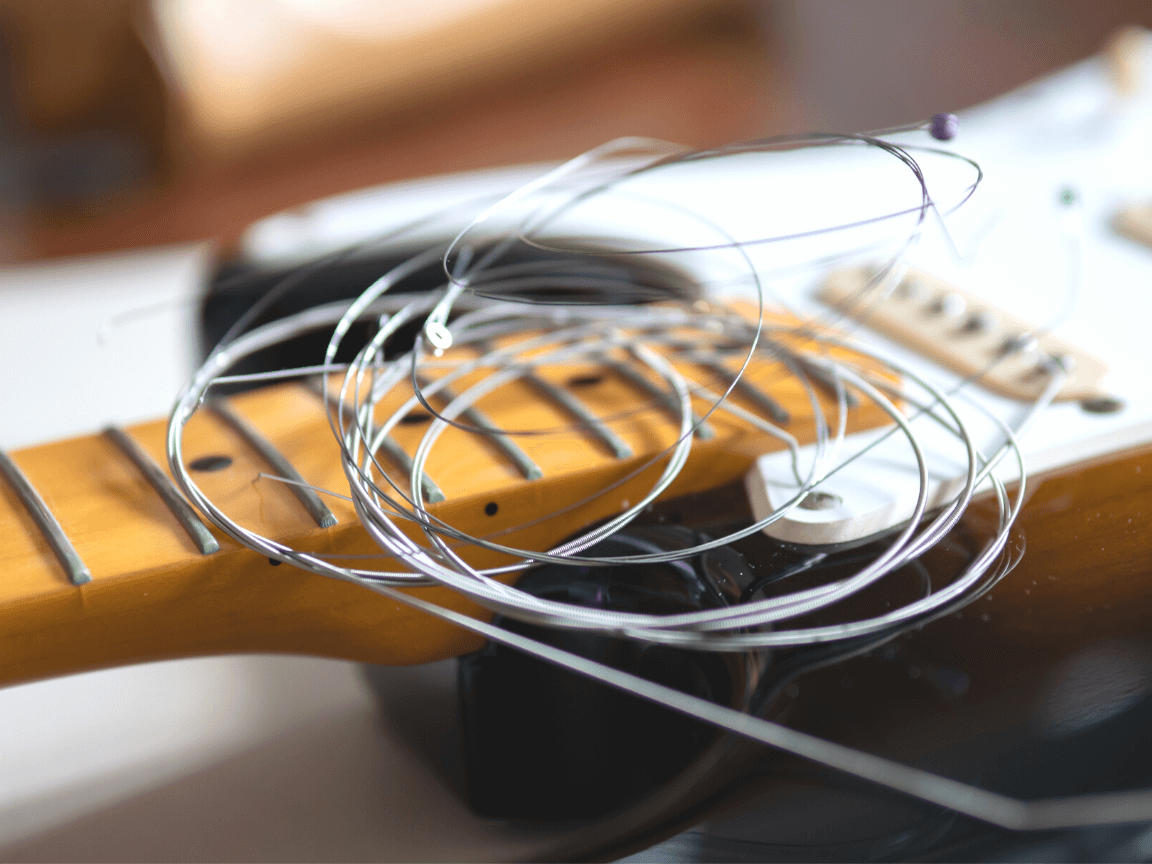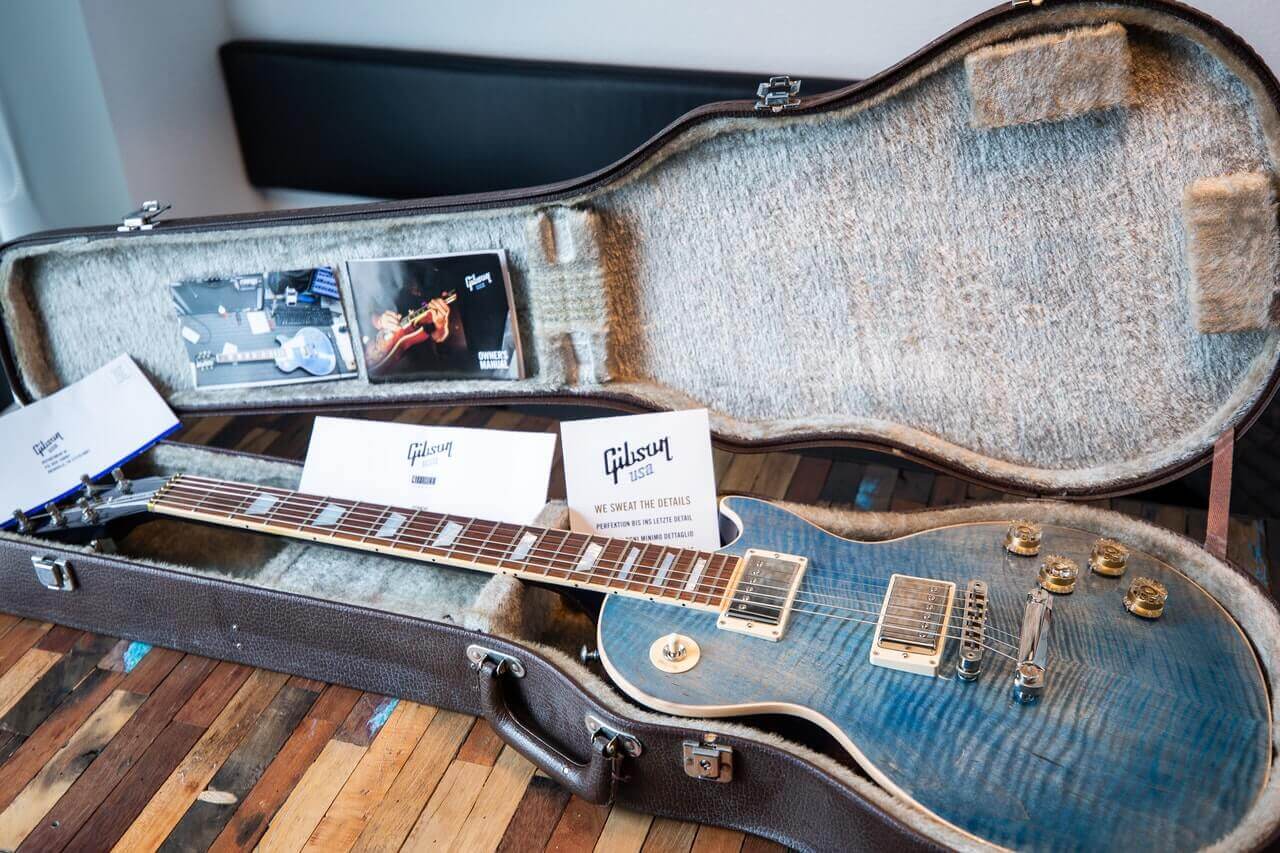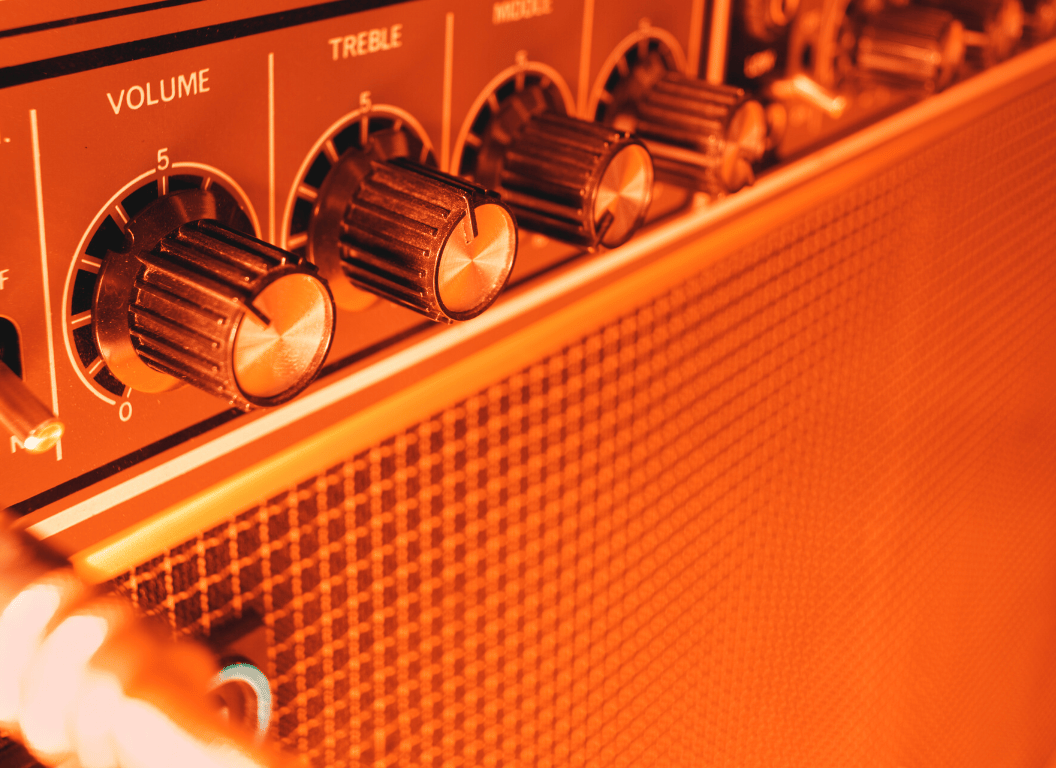How do you clean a guitar fretboard with household items?
I’ve been there, your guitar is looking dirty as it can be and you have none of those fancy products that they always want you to buy at every guitar store.
Do you just clean it with water? Perfume? How can you do so without damaging your instrument?
That is exactly what I will be talking about in this post.
Table of Contents
How to clean a guitar fretboard with household items?
The quick answer is that the best way to clean a guitar fretboard with household items is to just use things like Q-tips or cotton swabs to remove the dirt that is specifically located to the side of the fret and use cotton balls (or even face-cleaning pads) for the middle part in between frets. You should do this patiently with each fret and conveniently without any strings on your guitar. Using a little bit of water is usually preferred before using perfumes or any other liquid with chemicals that could potentially damage your guitar.
I have been playing guitar for many years and I have to say, a clean guitar really feels different and will even help your instrument last longer.
There are many ways in which you can clean your guitar without having to buy any product.
The next items that I’m going to list are some of those that won’t replace real guitar cleaning products but will keep your instrument in good shape.
Later on below, I will show you a step-by-step of how to use them to clean your fretboard.
1- Plain water
Yes, you read that right!
That same water that we drink every day and shower with.
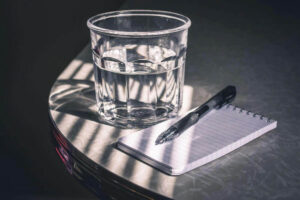
Water could be a great alternative to most products that you could attempt to clean your guitar with, which could potentially damage it.
If in doubt, just use water!
Plain water is free, readily available, with no harsh chemicals, no fire hazard, no health hazards, and you won’t be needing any protective equipment.
But I’m not talking about spraying your entire guitar soaking wet, or anything drastic.
Simply grab a cotton ball or microfiber cloth, and with a bit of water, slowly and patiently clean each individual fret in your guitar.
Now…
Many people will debate that using water will give you trouble when removing heavy dirt that could potentially be on your guitar if you haven’t cleaned it in a while.
This is very true!
And if that’s the case and your guitar is in really bad shape, then you should use something else.
But, if your fretboard is not that dirty and just needs a quick clean up, then you can never go wrong this way.
2- Guitar picks, or some old plastic cards
This depends on how bad your fretboard is looking, if the dirt is so noticeable that you can see it, then it might be a good idea to scrape it a little bit before you apply any products.
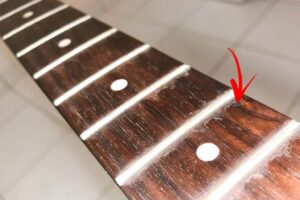
Things like old plastic cards (ex: old credit cards) or your guitar picks (if they haven’t disappeared yet) could be very useful when doing this.
In my case, I will use a small piece of cardboard from a Listerine Pocketpaks package.
This one even came with the corners cut, which turned out to be a very good approach.
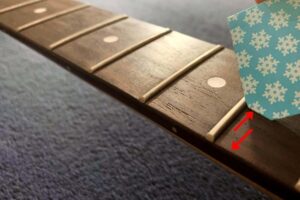
This Ibanez GIO that I’m using as an example, hasn’t been played in over a year. And to my surprise, it wasn’t that dirty since I’ve always kept it inside its bag.
You will want to horizontally push the dirt away, and if it is to close to the actual fret then just use one of the corners of the card or the top of your guitar picks to remove those.
Now…
This might sound a bit obvious but make sure that you don’t use a knife or anything that can scratch and leave marks on your fretboard.
You might be surprised at how many people have had this problem.
3- Using vegetable oil soap
Another thing that you can do is to see if you have vegetable oil soap around your house.
Notice I’m not talking about the vegetable oil that you use for cooking food in your house.
This is a special oil soap that is manufactured with water, coconut, plant-derived cleaning ingredients, natural fragrance, and 2% synthetic ingredients. It contains 98% naturally derived ingredients, pure vegetable oil and it’s very safe to use it on generally any wood type.
Here is an example:
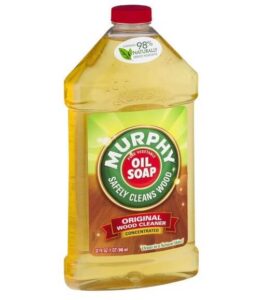
People usually have these around the house, so it makes them a perfect alternative to professional guitar cleaning products.
This specific product cleans to a natural shine and does not contain any unnecessary chemicals.
Use a little bit of this oil soap with any cotton ball or microfiber cloth, and after cleaning all the hard dirt on your fretboard, this will give it a great shine and feel.
If there is a lot of dust, remove it beforehand, and then easily apply it until you are satisfied with the results.
The good thing about these types of wood cleaning products is that not only can you use it on your fretboard, but also on your guitar body and neck.
Now…
I’ve also read, among many positive comments, one person saying that your guitar might get sticky.
For me, this hasn’t been the case, but if you want to be sure this doesn’t happen to you, then you can either mix the oil soap with a bit of water, use really small amounts at a time, or slightly remove it with a dry microfiber cloth after you’re done.
Either way, most of the time, your guitar shouldn’t need an excessive amount of any product if you clean it regularly.
4- Lemon oil
Lemon oil is a great way to clean your fretboard as all the dirt will be removed very easily and it will allow the wood to shine again if it’s dried out.
You have to be careful, though, with what type of lemon oil you use.
I’m not talking about lemon juice or encouraging you to just slice a lemon and use that to clean your fretboard.
This is a different type of product and the lemon concentration has to be close to nothing.
If you have lemon oil around the house, then it is safe to use it on mostly rosewood or ebony fretboards (generally anything but maple fretboards).
But again, very important, make sure that you don’t use actual lemon juice, and that if you have lemon oil, it’s lemon concentration is not high.
Take a look at an actual product made specifically for guitar fretboards:
They sell these Dunlop Fretboard Lemon Oil on Amazon and are very useful in keeping the dirt away with an invisible sealant that prevents stains and moisture.
If you want to check it out, I really encourage you to do so, this is one of the products I’ve used before, and it really does a great job.
You won’t be needing too much, this is not meant to be taken as the main product to clean the heavy dirt.
Rather, use it to give it its last touch of shine and moisture.
Without any exaggeration, one of these small bottles should last you, easily, more than one year.
5- Mineral spirits
Mineral spirits are very mild and won’t harm the finish. It’s worth a try as it’s awesome for getting sticky things off your fretboard.
You might be able to find it around your house!
A word of caution though…
If you do a quick search online, you will find, just like with any other product, a lot of uncertainty among guitar players on forums.
Cleaning your fretboard sporadically with mineral spirits is safe, but long exposure or even aggressive rubbing with the wrong type of mineral spirits can have unwanted effects on your fretboard.
So make sure to use these products as a quick alternative and not a lifetime solution until you find the right one made exactly for guitar fretboards.
Also, make sure to read what each of the products you use is made of. Usually, on the back of the bottle, it should list all the chemicals used.
Some of them will be marked as paint thinner or other specific titles containing chemicals that won’t really benefit your instrument in any way.
Different companies might also use different formulas or chemicals, so be aware of this before doing anything dangerous to your guitar.
The same thing applies to:
6- Naphtha
This product will be a little tricky to apply in small amounts because it will quickly evaporate, but that’s the way you want it to be.
Only use a little bit at a time as it will act as a way to remove oils from your fretboard. This will be very useful to clean up all the dirt that you leave with your own hands when playing.
But remember this…
Only use this product if you already have the appropriate oil to use right after, because if you don’t, then you will end up drying out your fretboard.
Like a few other items on this post, there are a lot of different opinions on using these liquids on guitars.
The grand majority of guitarists out there, though, don’t have anything negative to say about using this product, I’ve even seen brands recommend it, for example, Blueberry Guitars.
But I would still do some research based on the wood type that you are trying to clean, and how dirty your guitar is.
Products that you shouldn’t use
The list of products to not use is definitely longer than the list of products to use.
Many of the following products might pass as a very good alternative to cleaning your fretboard if, for example, you mix them with water or simply use just a little bit.
But due to many of them bringing a lot of uncertainty among guitar players, different opinions, and having different effects depending on the wood type, I will just list them as products that you should not use.
This will prevent you from using something that could potentially damage your instrument and will allow you to play it safe.
However, I do encourage you to do further research if one of them might seem like a good choice for you.
1- Furniture polish
I’ve read in more than one forum that using furniture polish is not the best thing to do.
People have shared that it tends to “dry out any exposed wood and it can permanently stain some kinds of finish.”
Researching around won’t bring any positive feedback either, so I would just stay away from it.
2- Bleach
Unless you’re intentionally trying to change the color of your fretboard, then do not use bleach under any circumstances.
You know is bad for a simple cleaning method, when you search it on Google and the only results you get are people asking how to make their fretboards a lighter color.
I would stay away from it.
3- Vinegar
Using vinegar is one of those products that also bring a lot of mixed feelings to the discussion.
You surely already know that white distilled vinegar is known to be an awesome household cleaner, and many people even use it on their fretboards.
But think about the smell…
Even if you use just a little bit, it tends to be a really strong smell, but many would argue that it goes away naturally within a few minutes.
I’ve never used it, and I will keep it that way for now.
4- Toothpaste
I’ve found toothpaste to also bring mixed emotions to this type of question.
Many guitar players have posted online how toothpaste has done wrong for them and they don’t know how to properly reverse the effects without further damage.
One thing you need to make clear with toothpaste is what exactly you want to achieve:
- Are you cleaning just the frets, meaning the metal strings within the fretboard?
- Are you trying to clean the wood?
- Or are you attempting to do both?
That right there will give you a perfect way to redefine your search; the products won’t be the same when you’re trying to clean wood, versus trying to clean metal.
Humans have been using toothpaste to clean CD’s surface for as long as I remember, so for some folks, the same logic applies.
Toothpaste is helpful for the frets, (meaning, the metal parts that you see across your fretboard), but do not apply it on the wood.
And if you’re trying to polish the frets…
Make sure that you cover the wood with tape or just use a professional fretboard guard.
5- Acetone
In many years of playing guitar, I’ve never seen, read, or heard anybody having a positive experience with pure acetone and their fretboards.
Acetone can be used as a powerful cleaner in many other cases, but it is extremely harsh to use it for this case in particular.
Some people argue that it can completely damage the fretboard finish.
Now, if you find yourself having acetone as your only option…
Then you might be able to just use one drop and mix it with water, but if I were you, I wouldn’t do this more than once.
6- Sandpaper
If in some situations, you cannot remove the dirt from the guitar with the help of anything, do not attempt to use sandpaper.
Even less if you are trying to clean the actual wood on the fretboard and not the frets.
You will literally scratch it and then the amount of work and time that you will need to spend to get it to look like it was, will be unreal.
Sandpaper tends to be useful in polishing the actual frets, but not the fretboard itself.
If you are planning on polishing the actual frets, make sure to use a fret guard or something similar to protect your equipment.
More on that right below.
Cleaning your guitar fretboard – Step by step
Now that you know about some of the products or items that you can and can’t use, let’s put it all together…
Step 1: Placing your guitar in a safe place
Before you even start to clean your guitar is very important that you place it in a way that you won’t damage it.
For example, do not try to clean your guitar on the floor.
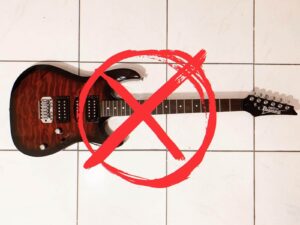
This will, most of the time, scratch your guitar’s body, and it will be very uncomfortable for you to even clean it properly.
What you can do, though, is to use a table and place your instrument over some bedsheets or something with a similar texture.
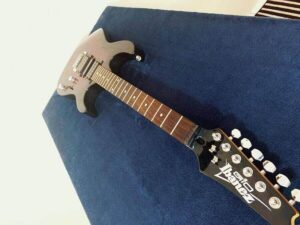
As you can see in these pictures, the guitar won’t be damaged or scratched in any way by the table’s surface and it’s just better for you to nicely work on it.
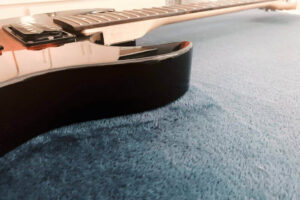
But why am I even saying all this?
Well, I used to clean my guitars anywhere I found convenient. From using the floor, to my own bed; I just wouldn’t recommend doing it like that.
Remember, you will be removing all the strings, which oftentimes, will leave small pieces all over the place.
Step 2: Removing all the strings
If you’re planning on doing a deep cleaning to your fretboard, then I would just encourage you to remove all the strings at once.
Even if you’re not planning on getting rid of them, it will be much better for you to have them all removed, rather than working your way up, one by one.
If you have never done this before, then the first thing you would need to do is loosen up each string as much as you can. Then depending on whether you want to reuse them or not, you would just cut them, or remove them carefully.
And just in case you’ve heard about the old debate on whether you should take all the strings off your guitar at once or not, I encourage you to watch this YouTube video.
He talks about how it’s not that big of a deal to remove them all at once and how your guitar won’t get severely damaged at any point.
Step 3: Cleaning your fretboard
First of all, I want to talk about the terminology that I will use, just so that we are on the same page.
When I say “frets”, I will be referring to the strips of metal embedded on your guitar’s fretboard. And when I say “fretboard”, I mean to refer to only the wood.
Now…
The first thing that we will do is clean the frets.
Before we do so, we need to protect the wood. Some people like to use tape or a fret guard, like this one:
Today, I’m not using any of those, but rather I’m making my own fret guard.
Making a fret guard
If you are interested in doing it as well, then the only thing you need is some sort of strong cardboard that bends, some scissors, and a pen.
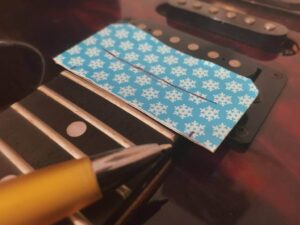
Just go to the last fret of your guitar, and draw some measurements, just like in the picture above.
The reason we do this is that we will eventually be cleaning each one of the frets, and if you notice, they get bigger as you go further into the last frets.
Now…
After that, cut a hole in the middle, wide enough that it could entirely fit a fret.
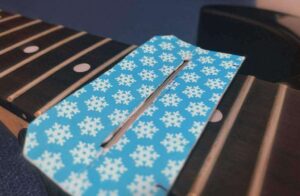
Polishing the frets
Sometimes, even after cleaning the entire fretboard, you will find out that the frets are still dirty.
Just like in this image:
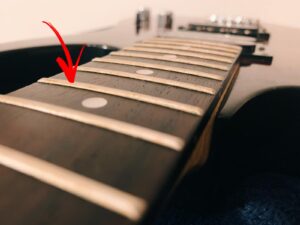
These stains are not very noticeable from far away (and most of the time you are not going to be doing all this work), but they are definitely there.
In this case, you could use a nail file together with some toothpaste (separately, and in this exact order) to clean the frets.
Important: Do not do this on the wood, you will scratch it. And if you’re using toothpaste, make sure to use extra protection on the wood such as low tack protective tape.
In my case, I’m only using a nail file to slowly and patiently get rid of the yellow stains.
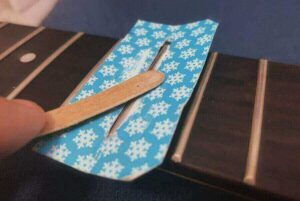
Then with that same fret guard we just made, or a different piece of cardboard, I will start scraping all the heavy dirt on the guitar.
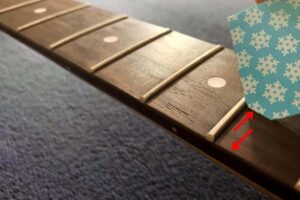
This guitar wasn’t too dirty, to begin with, but if yours is, then just do it like is being shown in the pictures above.
After that, you can just grab a small cotton ball, and start cleaning the fretboard.
Cleaning the fretboard
Since the main topic of this post is to only use household items, I will just be using water as of right now.
Notice I’m not going to be spraying it directly to the fretboard.
I’m putting a bit of water on the cotton ball, and then I will use that to clean the dirt.
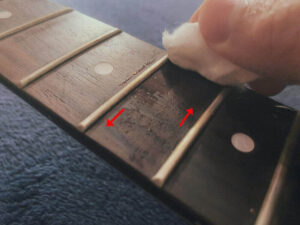
To be completely transparent with you, water doesn’t remove as much dirt as you might think it would, and in my opinion, it just seems to dry the wood a bit too much.
Just so you can have an idea:
After I thought I had cleaned it with water perfectly, I decided to apply real products, and the dirt that kept coming out was unbelievable.
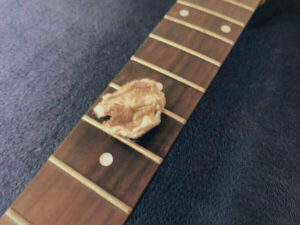
I used these two products from Dunlop’s 6500 System 65 Guitar Maintenance Kit:
If you want to check out the entire kit, I would highly recommend it. The best thing about it is that I bought this kit almost 2 years ago, and I still have it.
As to how to use them, the label itself helps you figure it out with the big-sized 01 and 02 and its directions on the back of the bottle.
First I just applied the Fingerboard Cleaner & Prep using a cotton ball.
Remember, you should generally never spray products directly on your guitar.
You will use way more than you need and is really not a safe thing to do to the fretboard wood.
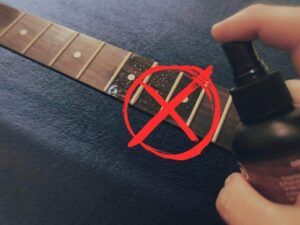
After that, I applied the Fingerboard Deep Conditioner.
You should apply this product within each fret, one at a time, and then let it rest for a good five to ten minutes.
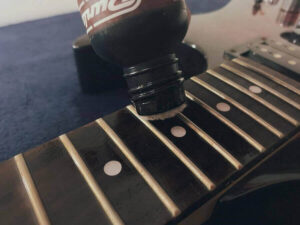
I always like to then get an unused cotton ball and remove any excess conditioner that I may have put by accident.
This is where most people go wrong; they put in way too much product and then say that it makes the fretboard sticky.
It doesn’t make the fretboard sticky, you’re just putting more than you should.
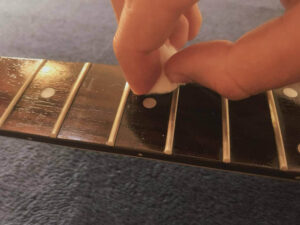
The reason I’m sharing this last part is simple.
You could get away with cleaning your guitar with household items a few times, but just like I said before, I don’t think you should rely on these methods all the time.
How to prevent your fretboard from getting dirty
Clean your hand before playing
This is something I don’t even do most of the time!
But…
It will go a long way if before you play your instrument, you just clean your hands and get rid of any sweat or oil on them.
Your guitar will be much cleaner and you won’t have to be doing all this process all the time.
Don’t hang your guitar on a wall
I’m telling you this while I have a few of my guitars on the wall.
It looks good and to be honest, I will keep them there : )
But just know that a lot of dust will accumulate on your instrument over time, and this, combined with your sweat, is the perfect formula for a dirty guitar.
Clean your guitar after using it
Take a few seconds to clean it up after playing your guitar.
Just use a microfiber cloth or something similar and clean up the places that you would normally touch the most.
Doing these things is a great way of keeping your instrument in good shape.

An avid storyteller and music lover that devotes all his free time to mastering the art of playing guitar. I’ve played acoustic for 6 years, and recently started playing electric guitars. Currently playing an Epiphone SG Special!

